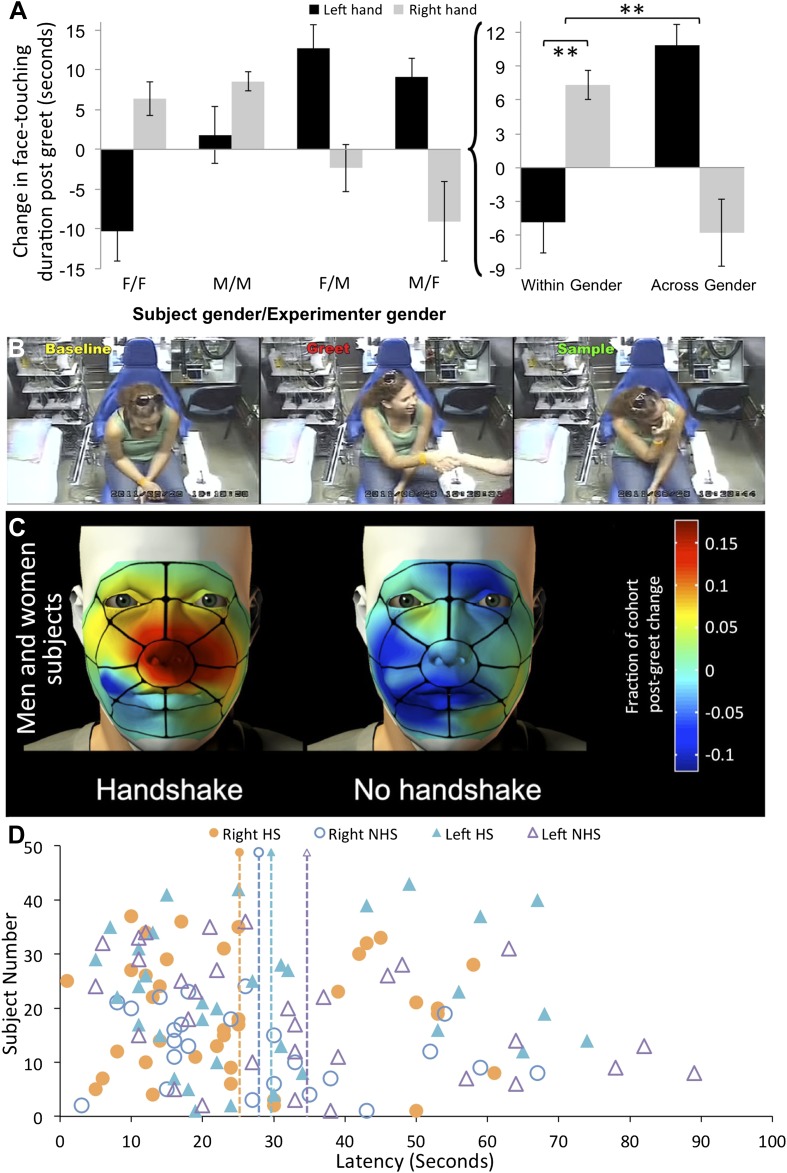The color legend reflects the type of interaction: subject gender (F/M), experimenter gender (F/M), and nature of greet with or without handshake (HS/NHS). The raw data for this analysis are in
Supplementary file 1, and the ANOVA table is in
Supplementary file 2. We conducted a repeated measures omnibus analysis of variance (ANOVA) with factors of subject gender (M/F), experimenter gender (M/F), and nature of greet (handshake/no-handshake), and a dependant repeated compact variable of exploration change time for right (shaking) and left (non-shaking) hands (hand). The ANOVA revealed no main effects or secondary interactions other than one highly significant interaction of subject gender × experimenter gender × greet × hand (F[1,145] = 12.75, p = 0.0005). This reflected a gender × experimenter gender × greet interaction for the right shaking hand (F[1,145] = 9.46, p = 0.0025), whereby both men and women equally (F[1,152] = 1.06, p = 0.3) increased apparent olfactory right hand exploration after shaking the hand of a same gender individual (change after handshake greet = 2.14 ± 8.1 s, change after no-handshake greet = −5.39 ± 15.3 s, t[71] = 2.69, p = 0.009), but not the hand of an opposite gender individual (a trend in the opposite direction, towards decreasing hand exploration: change after handshake greet = −4.85 ± 18.92 s, change after no-handshake greet = 0.94 ± 5.58 s, t[78] = 1.84, p = 0.07). In other words, individuals significantly increased right hand exploration only following the same gender greets that contained a handshake. In contrast, for the left non-shaking hand, a gender × experimenter gender × greet interaction (F[1,145] = 5.14, p = 0.02) reflected mostly trends, which moreover were in the opposite direction from the right hand. Specifically, both men and women equally (F[1,145] = 0.53, p = 0.47) did not change left non-shaking hand exploration after shaking the hand of a same gender individual (change after handshake greet = −2.85 ± 16.72 s, change after no-handshake greet = 1.64 ± 22.08 s, t[71] = 0.99, p = 0.33), yet had higher left non-shaking hand exploration after shaking the hand of an opposite-gender individual (change after handshake greet = 2.91 ± 11.84 s, change after no-handshake greet = −7.95 ± 28.33 s, t[78] = 2.26, p = 0.03). Note that this latter effect was not driven by increases in sampling after the handshake greet (+2.9 s), but rather by avoiding self-sampling after no-handshake greet (−7.95 s). Taken together, these data imply that after greeting individuals across gender without a handshake, humans may increase left non-shaking hand exploration, yet after shaking hands with individuals of the same gender humans robustly selectively increase investigation of only the hand that shook.


